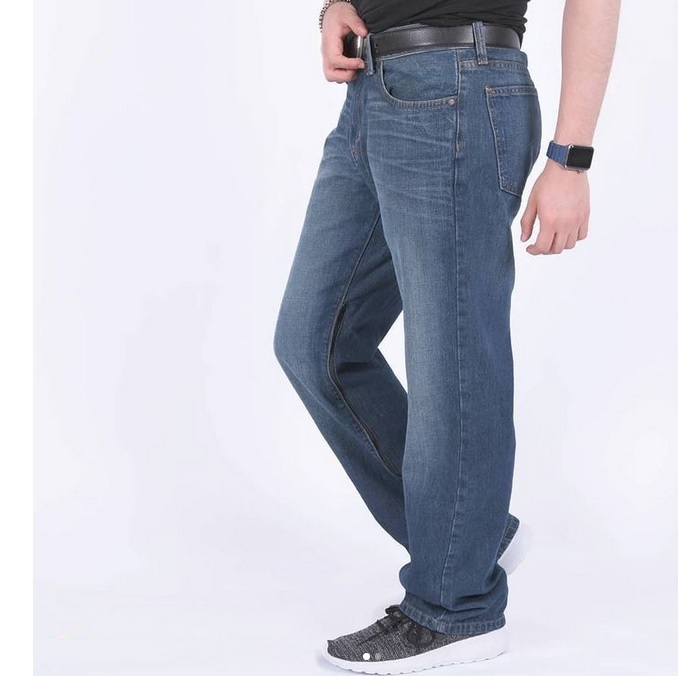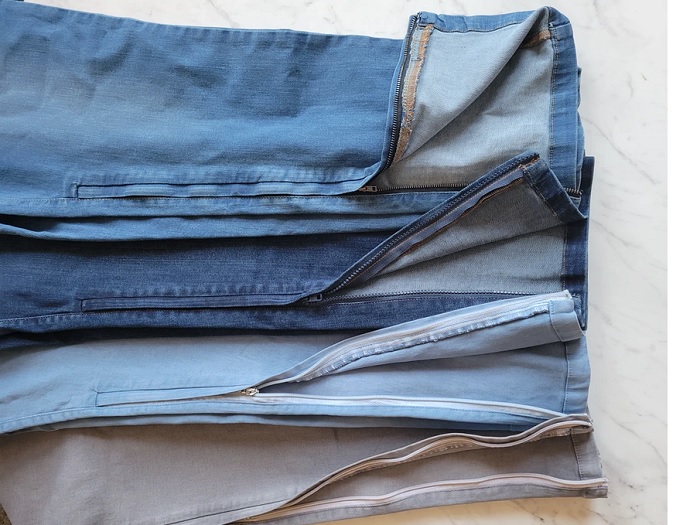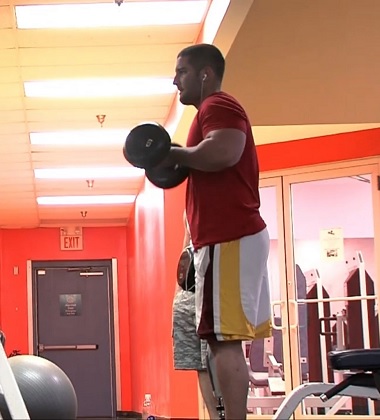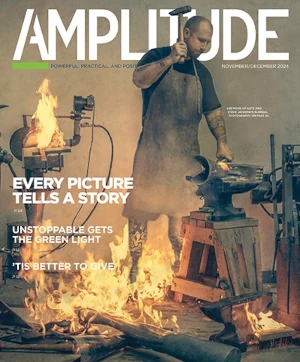Erica Cole was kind of shocked to find out how complicated it is to manufacture a simple pair of blue jeans.
“They’re one of the hardest things to make in the apparel world,” she says, “because there are so many steps and so many details. There’s the raw denim that has to be assembled and stitched. And then you think about all the extra hardware—all the little rivets, the extra pockets, the buttons that aren’t necessarily on other types of pants. The machines have to be very precise. And the real challenge, the extra step after the pants are assembled, is they have to go to a wash house and the denim has to be washed and dyed. And then there are more details to add after that.”
This multi-stage process doesn’t even account for the extra-extra steps needed to produce the amputee-friendly jeans Cole designed after losing her leg in a 2018 auto accident. Her soon-to-debut Amp Pants come equipped with inseam zippers, reinforced fabric, and other enhancements to accommodate the prosthesis-wearing casual dresser. Conceived with input from a few hundred amputees and prosthetists, Cole’s jeans are meant to fuse the comfort and durability of conventional denim with easy-on/easy-off convenience and ready access to residual limbs, sockets, and joint hardware. They’re currently available for pre-order and should be shipping by August.
This is not the kind of problem the 25-year-old Cole expected to be solving in the early stages of her career. Before her accident she’d been on track for a job in actinide chemistry at Los Alamos National Laboratories. Limb loss threw a wrench into those plans, Cole says, but her scientific mindset kicked in almost immediately and helped her refocus her sights. Within two days of her operation, she was gathering data about amputee life from Facebook forums and other sources online. Before long she’d turned her attention from splitting atoms to cracking a nut that’s nearly as complex: how to dress well as an lower-limb amputee.
“My first prosthesis was huge,” she says. “It was so big and bulky, and I couldn’t wear anything. At first I thought it was a ‘me’ problem. I thought I was the only one struggling with it, because everybody else seemed to have a handle on it. But they didn’t. As I talked to people, I found out other amputees were struggling to dress themselves.”
It so happened that Cole already knew a thing or two about making nonstandard apparel. While earning her chemistry degree from the University of Iowa, she built up a thriving side hustle as a costume designer, creating clothes for the school’s theater program and for fellow students who wanted to look sharp at Comic Con, Renaissance festivals, and other cosplay events. Along the way she picked up a number of tricks for hiding fasteners, seams, and other visual intrusions, and those skills came in handy when it came to adapting her old wardrobe to her new body.
“I started sewing zippers into my pant legs,” she says, “and people were like, ‘Hey, that’s really awesome, you should make a business out of that.’ I thought maybe it could be a little Etsy shop or something.” Cole dubbed her new venture No Limbits and showed up at the 2019 Amputee Coalition National Conference wearing a pair of her modified jeans and a t-shirt that said, “Ask me about my pants.” Lots of people inquired, and Cole started getting more orders than she could possibly fill as a one-person operation.
“I was altering clothing by hand,” she says. “It got to the point where I was on a sewing machine all day long, and it was not working as a business. I also realized I could make better clothes if I started from scratch. You can only alter to a certain extent.”
She attended a pitch conference in Chicago later that year and was spotted by a representative from Target, who urged her to apply to the company’s prestigious Incubator program. When the acceptance notice arrived, it dawned on Cole that her idea might have more than Etsy-level potential. That’s also when her process for producing jeans grew from a simple matter of sewing and stitching into a complex sequence of design, procurement, manufacturing, and engineering equations.

“We had Target’s VP for clothing and apparel working with us and guiding us through the supply chain questions, which is just mind-blowing,” Cole says. “We had the head of [Target’s] denim lines advising us. Those subject-matter experts really allowed us to learn enough to put this thing together. Without that, I might still be sewing them one at a time on a sewing machine.”
No Limbits gathered further momentum when Cole brought Runway of Dreams founder Mindy Scheier onto her advisory board. She also forged connections with Zappos Adaptive and other big players in adaptive fashion. The final piece of the puzzle was raising the seed money to activate the assembly line, and that turned out to be the easiest part of the whole process. Last month Cole launched a Kickstarter campaign to finance the Amp Pant’s inaugural production run. It only took about a week to top the project’s $12,000 fundraising goal.
“I was not expecting that,” she says. “I was expecting to be on pins and needles for the entire 35 days of the campaign, waiting for the last dollar to come in. So it was a very pleasant surprise, and definitely a relief, when we met our goal so quickly.”
Like everything new in adaptive fashion these days, the Amp Pant is designed for universal access—you don’t have to be an amputee to feel comfortable in these jeans. They’re available in men’s and women’s sizes in multiple hues, and Cole plans to introduce a companion line of joggers before the end of this year. Place your order at No Limbits’ website. The first shipments are expected in August.
Read more about amputee fashion in Amplitude:
Amputee Clothing Gets a Lift From Uniteable
Adaptista Wants to Raise the Bar on Inclusive Fashion
Fashion Forward
More Than a Cover
Four Up-and-Coming Amputee Models






